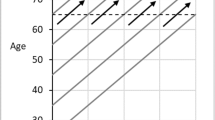Abstract
In 2007–2008 the Council of Australian Governments agreed to six ambitious targets for addressing longstanding disparities between Indigenous and other Australians in health, education and employment outcomes. The ‘National Integrated Strategy for Closing the Gap on Indigenous Disadvantage’ (colloquially ‘Closing the Gap’) includes the goal of eliminating life expectancy gaps within a generation. This policy says nothing about what changes in the demographic structure of the population might be expected should there be even partial success towards this ambitious target. Information is required to analyse age and sex shifts for their effects on service demand and provision. In this study we apply cohort component projections modelling to the Northern Territory, the Australian jurisdiction with the largest Indigenous component in its population and the largest life expectancy gaps, to assess the demographic effects of closing the gap within a generation. Three scenarios are modelled: (1) No changes to Indigenous life expectancies from those estimated in 2010; (2) Complete success in closing the gap within a generation; and (3) A continuation of current forecasts about how Indigenous life expectancies will change into the future. Although closing the gap would only produce a small increase in the size of the next generation’s Indigenous population, over and above that projected with lower life expectancy scenarios, it would result in substantial changes in age compositions, with associated shifts in various demographic indices. These are pertinent to the planning and funding of core services into the future.








Similar content being viewed by others
References
Altman, J., Biddle, N., & Hunter, B. (2008). How realistic are the prospects for ‘Closing the Gaps’ in socioeconomic outcomes for Indigenous Australians? CAEPR discussion paper No. 287/2008. Canberra: Centre for Aboriginal Economic Policy Research.
Australian Broadcasting Corporation (ABC). (2009). ‘Bureaucracy to blame’ for Indigenous gap. 3 July. Accessed June 3, 2011, from http://www.abc.net.au/news/stories/2009/07/03/2616419.htm.
Australian Bureau of Statistics (ABS). (2001). Demography working paper 2001/4: Issues in estimating the Indigenous population, 2001. Cat. No. 3126.0. Canberra.
Australian Bureau of Statistics (ABS). (2009a). Experimental estimates and population projections, Aboriginal and Torres Strait Islander Australians, 1991 to 2021. Cat No. 3238.0. Canberra.
Australian Bureau of Statistics (ABS). (2009b). Experimental life tables for Aboriginal and Torres Strait Islander Australians. Cat. No. 3302.0.55.003. Canberra.
Banks, G. (2008). Overcoming Indigenous disadvantage in Australia. Address to the second OECD World Forum on ‘Statistics, Knowledge and Policy’, Measuring and fostering the progress of societies. Istanbul, 27–30 June, 2007.
Barnes, T., Smith, L., Zhao, Y., & Guthridge, S. (2008). A comparative analysis of indirect methodologies for estimating Indigenous life expectancy. Darwin: School for Social Policy and Research, Charles Darwin University.
Birrell, B. (2000). Intermix and Australia’s Indigenous population. People and Place, 8(1), 61–66.
Cooke, M., & Belanger, D. (2006). Migration theories and first nations mobility: Towards a systems perspective. Canadian Review of Sociology, 43, 141–164.
Council of Australian Governments (COAG). (2008). National integrated strategy for Closing the Gap in Indigenous disadvantage. Accessed June 15, 2011, from http://www.coag.gov.au/coag_meeting_outcomes/2009-0702/docs/NIS_closing_the_gap.pdf.
Department of Health and Ageing. (2004). Review of pricing arrangements in residential aged care: Full Report. Accessed January 6, 2011, from http://www.health.gov.au/internet/main/publishing.nsf/Content/healthinvestinginagedcare-report-index.htm~health-investinginagedcare-report-footnotes.htm#5-15.
Hill, K., Barker, B., & Theo, V. (2007). Excess Indigenous mortality: Are Indigenous Australians more severely disadvantaged than other Indigenous populations? International Journal of Epidemiology, 36, 580–589.
Madden, R., Tickle, L., Pulver, L. J., & Ring, I. (2012). Estimating Indigenous life expectancy: Pitfalls with consequences. Journal of Population Research, 29(3), 269–281.
Northern Territory Government. (2010). Mortality in the Northern Territory 1967–2006. Health Gains Planning Information Sheet, December 2010. Darwin: Health Gains Planning Unit.
Northern Territory Treasury. (2011). Northern Territory population projections, 2011. Darwin: Northern Territory Government.
Rasmussen, R. (2007). Polar women go south. Journal of Nordregio, 7(4), 20–22.
Taylor, A. (2009). Population projections for the Northern Territory: An uncertain future. Darwin: Charles Darwin University. Accessed September 13, 2012, from http://www.cdu.edu.au/sites/default/files/Brief2009041populationprojectionsforthent.pdf.
Taylor, A. (2011). The forecasting of remote area populations: Numbers aren’t everything. In D. Carson, R. Rasmussen, P. C. Ensign, L. Huskey, & A. Taylor (Eds.), Demography at the edge: Remote human populations in developed nations (pp. 39–52). Farnham: Ashgate Publishing.
Taylor, A., Johns, G., Steenkamp, M., & Williams, J. G. (2011). The ‘problem’ of Indigenous migration in the globalised state. In D. Carson, R. Rasmussen, P. C. Ensign, L. Huskey, & A. Taylor (Eds.), Demography at the edge: Remote human populations in developed nations (pp. 163–188). Farnham: Ashgate Publishing.
Williams, G. (2010). Anchorage migration: The movement between Alaska’s major Native areas and Anchorage. February: Alaska Economic Trends.
Wilson, T. (2009). A multistate model for projecting regional populations by Indigenous status: An application to the Northern Territory, Australia. Environment and Planning A, 41(1), 230–249.
Wilson, T., Condon, J., & Barnes, T. (2007). Northern Territory Indigenous life expectancy improvements, 1967–2004. Australian and New Zealand Journal of Public Health, 31(2), 1–8.
Acknowledgments
NTPOP was initially conceived and developed by Dr. Tom Wilson, now of The University of Queensland. The authors wish to thank Dr. Wilson for his valuable contribution to the understanding and forecasting of populations in the Northern Territory.
Author information
Authors and Affiliations
Corresponding author
Rights and permissions
About this article
Cite this article
Taylor, A., Barnes, T. ‘Closing the Gap’ in Indigenous life expectancies: what if we succeed?. J Pop Research 30, 117–132 (2013). https://doi.org/10.1007/s12546-013-9106-0
Published:
Issue Date:
DOI: https://doi.org/10.1007/s12546-013-9106-0




